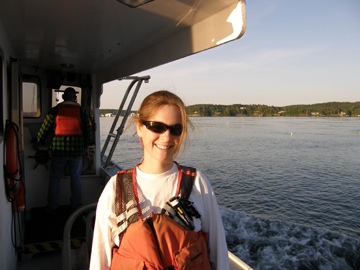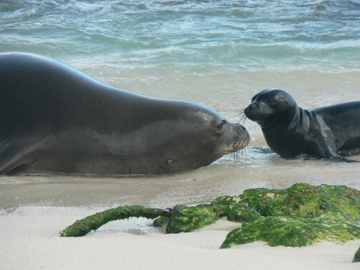Expedition granted?: hoping to save nearly-extinct seals through National Geographic contest
Expedition granted?: hoping to save nearly-extinct seals through National Geographic contest
Jeremy Hance
mongabay.com
March 24, 2011
The Critically Endangered Hawaiian monk seal (Monachus schauinslandi). Photo by: Brenda Becker.
Dashiell Masland, known as 'Dash', has always been in love with the sea and its inhabitants. Now, she is hoping to take that passion to the Hawaiian Islands to save one of the world's most threatened marine mammals: the Hawaiian monk seals (Monachus schauinslandi). Extinction is a real possibility: already, the related Carribbean monk seal vanished forever around 1950. Decimated by sealers, whalers, and even soldiers in World War II, the Hawaiian monk seals are struggling to make a come back with only 1,100 individuals surviving and the population decreasing by 4% a year. Today many face starvation due to a lack of prey. This is where Masland, who is currently competing in National Geographic's Expedition Granted, hopes to help.
"I am going to be studying the dietary habits of [a] small population of Hawaiian monk seals that are actually increasing. We don’t have a clear picture of their diet at this point and I will be using sophisticated DNA techniques to get sensitive and accurate data. The foraging ecology of these animals is a critical component to understanding the prey and habitat needed by the only growing population of Hawaiian monk seals in order to identify areas of potential overlap between seal diet and human use of marine resources. If we can make management decisions that will help this small population continue to increase, it may be the answer to saving this species from extinction."
National Geographic's Expedition Granted is an online voting contest to award a researcher $10,000 to undertake the expedition of their choice. Masland is currently competing with Trevor Frost who hopes to study threats to protected areas in Indonesia [read about Frost's proposal here]. The winner will be announced on April 7th; the runner-up receives $2,500.
"It is very easy to register and when you vote you are entered to win a trip to the Galapagos aboard the National Geographic Expeditions ship! AND, you can vote once a day, every day until April 7th and be entered each time!" says Masland.
To vote for either candidate: Expedition Granted
INTERVIEW WITH DASH MASLAND
Mongabay: What drew you to marine biology?
Dash Masland: I grew up on the coast of Maine and have always been fascinated by the water. It has a completely calming effect on me and I am in wonder of the fact that it is so vast and there is so much going on under the water, and yet all we can see at most times is the deceptively calm surface.
Dash Masland. Photo courtesy of Masland.Literally as far back as I can remember I have wanted to be a marine biologist. I spent a ton of time growing up exploring the tide pools, beaches, and islands Because I love the ocean so much, I also recognize that it is in great danger. We overfish, destroy habitat and put many pressures on marine mammals that make it hard for species to survive. The ocean ecosystems are very fragile and it is one of the most important habitats on earth. Not only does it support a huge percentage of life on this planet, the ocean also provides more than 75% of the oxygen we breath through photosynthetic algae. Incredible! I really just want to help preserve this amazing, diverse, vastly unexplored, and absolutely essential habitat.
Mongabay: What makes the Hawaiian monk seal unique?
Dash Masland: Hawaiian monk seals (Monachus schauinslandi) are incredible marine mammals in so many ways. Broadly, they belong to the order Pinnipedia, or "fin-footed" which includes all seals, sea lions and walruses. These marine mammals are amazing because they are actually considered "semi-aquatic" meaning they have evolved to live both in the water and on land. That is no easy accomplishment! They mate, give birth and raise their young on land. They haul out to rest and sleep on rocks and beaches and need to be able to escape predators on land. And then, they do all their foraging underwater at depths of up to 800 feet and have to be able to out-swim both their prey and predators.
Monk seals are then even more unique because they are considered "living fossils". This means that they have evolved so little from their ancestor that was alive 15 million years ago they are considered to be the same species. The Hawaiian monk seal has been in Hawaii for 10 million years. In addition, they are only found in Hawaii today and are one of the few marine mammals that’s geographic range is limited to one country.
Mongabay: Why are they so threatened?
Dash Masland: The Hawaiian monk seal was hunted to near extinction in the 1800's by sealers, shipwrecked crews, and feather and guano hunters. There was another major decline in the early 20th century with evidence linking this to military activity. The population has since struggled to rebound. It has been fully protected for the past few decades and their primary habitat in the North West Hawaiian Islands has been protected as a marine park for years. However, the monk seal is still not recovering. It is thought that the main reason for the lack of recovery is that most monk seal pups die of starvation. They have a less than 1 in 5 chance of making it to adulthood. This is probably due a shift in the availability of food and to competition for fish resources from other seals and other species such as sharks.
Dash Masland working in the lab. Photo courtesy of Masland.Mongabay: What role do they play in the ecosystem? In other words, if they vanish will there be ecological ripples?
Dash Masland: Monk seals and seals in general are considered to be top predators. While they still have predators of their own, they are at one of the highest trophic levels in their ecosystem. Top predators are considered to be crucial to marine ecosystems for a variety of reasons. First, they keep the entire ecosystem populations in check. Ecosystems evolve to have a delicate balance of species, niches and population numbers. If we were to loose the Hawaiian monk seal it would be hard to say what the ripple would be. But surely some of their prey items would exponentially increase without being predated upon. And then that species would over-forage on the next trophic level down, decimating those populations and potentially crashing the ecosystem. Therefore, loosing a top predator can have huge consequences for an ecosystem. Have you heard the classic sea otter and urchin example?
The other thing that top predators help to do in a marine ecosystem is nutrient cycle. By consuming fish and then defecating in the ocean, Hawaiian monk seals release the nutrients from the fish back into the water and makes them bioavailable for photosynthetic algae, for example, which produce most of the oxygen we breath on this planet and are at the bottom of the ocean food web.
Mongabay: There is one population of Hawaiian monk seals that is growing. Do researchers have any idea why this is?
Dash Masland: We are not really sure why this is. This is why we need to get in there and study the biology and ecology of this small population so we can better monitor its growth and help managers come up with effective strategies to allow seals and humans to coexist in the Main Hawaiian Islands (MHI).
Mongabay: How are you proposing to aid Hawaiian monk seals through Expedition Granted?
Dash Masland: I am going to be studying the dietary habits of the small population of Hawaiian monk seals that are actually increasing. We don’t have a clear picture of their diet at this point and I will be using sophisticated DNA techniques to get sensitive and accurate data. The foraging ecology of these animals is a critical component to understanding the prey and habitat needed by the only growing population of Hawaiian monk seals in order to identify areas of potential overlap between seal diet and human use of marine resources. If we can make management decisions that will help this small population continue to increase, it may be the answer to saving this species from extinction.
Hawaiian monk seal with pup. Photo by: Brenda Becker.Mongabay: Given the many threats facing the ocean today—overfishing, climate change, pollution—how optimistic are you that species like the Hawaiian monk seal will survive?
Dash Masland: I'm not really sure the answer to this one, but I do know that I won't want to watch them go extinct without feeling like I’ve done everything I can to help. Here is what I do know: If we can remove marine debris from the ocean and alleviate fishing pressures in their critical habitat and make management decisions in the favor of these animals, I think there is a good chance they will be able to make it. Many populations of animals are able to rebound when we just figure out what it is they need to do so. And, the Hawaiian monk seal has been alive for 15 million years. I would like to think that if they have survived that long, that with a little help from us they could live for another 15 million!
Mongabay: Where can people vote?
Dash Masland: People can vote for me at Expedition Granted. It is very easy to register and when you vote you are entered to win a trip to the Galapagos aboard the National Geographic Expeditions ship! AND, you can vote once a day, every day until April 7th and be entered each time! You can follow my adventure on twitter @DashMasland or on Facebook at DashMasland. Join me and help spread the word to save the critically endangered Hawaiian monk seal. Thank you!
' + ''; } else if (google_ads[0].type == "image") { ad_unit += ' 1) { ad_unit += '
.568.jpg)


